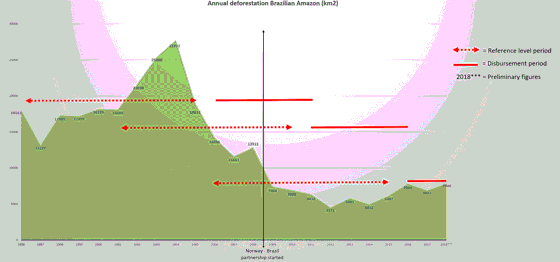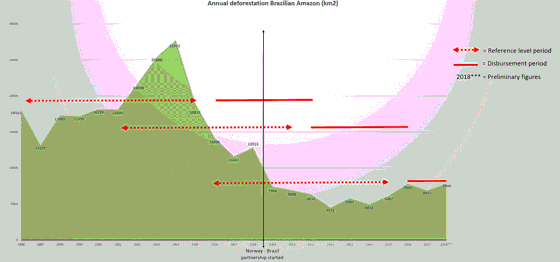Norway to pay USD 70 million to Brazil
Historical archive
Published under: Solberg's Government
Publisher: Ministry of Climate and Environment
News story | Date: 04/12/2018
Norway will pay USD 70 million (NOK 600 million) to Brazil for reduced emissions from deforestation in the Amazon in 2017, line with climate and forest cooperation between the two countries.
- After two years of increasing deforestation, Brazil’s efforts in 2017 were encouraging: Deforestation dropped by 12 percent compared to the year before, and was 64 percent below the average of the decade prior to Brazil’s initiation of large-scale forest reforms in 2004, says Norwegian Minister of Climate and Environment, Ola Elvestuen.

Elvestuen says Brazil has achieved very good results in the Amazon over the last decade. Over the period of collaboration, Brazil has saved the atmosphere from emissions of more than 4,5 billion tons of CO2, almost 100 times Norway’s annual emissions.
This year’s payment from Norway to Brazil of USD 70 million is remuneration for the reduction of deforestation in the Brazilian Amazon achieved in the forest year 2017 (August 2016-July 2017). The funds are disbursed to Brazil’s Amazon Fund, which supports projects that further reduce deforestation and improve the livelihoods of people living in the Amazon region (see fact box below on how Norwegian contributions are spent).

Alongside Norway, Germany also makes significant contributions to the Amazon fund.
- It is encouraging that Brazil managed to reduce deforestation in the Amazon last year, despite a challenging economic situation, says Elvestuen.

Recent deforestation trends are worrying
While Brazil can demonstrate reduced deforestation in 2017, preliminary figures indicate that logging increased in the forest year 2018. In a recently published estimate, Brazil's National Institute for Space Research (INPE) presented 2018 deforestation figures at 7900 km2. This corresponds to a 13,7 percent increase in deforestation from 2017 to 2018. The figures are still preliminary, but the possible increase gives reasons to concern both in Brazil and in Norway.
History has shown that deforestation in the Amazon rainforest often increases during election years.Brazil has just completed presidential and congressional elections in 2018.
The figures will only be verified next year, and will first then give the basis for payment from Norway in 2019, in line with the rules of the results-based cooperation between the two countries.
- We look forward to talking to the new government about Brazil’s future plans and our bilateral cooperation. We hope and believe that Brazil will continue to show the world that it is possible to reduce deforestation while increasing agricultural production in a sustainable way. It is very positive that Brazilian businesses, and especially the agribusiness, are increasingly contributing to the efforts against deforestation in the Amazon.
Brazil has previously shown that growth in agricultural production is possible without negatively affecting the rainforest.
According to Brazil’s Ministry of Environment, there are several reasons behind the rise in deforestation in 2018. Increased demand for Brazilian agricultural products has stimulated the opening of new forest areas. Longer and more severe dry seasons have led to a significant increase in forest fires. The increase in organized crime and illegal logging is often tied to other criminal activities, such as the illegal arms trade..
Norway is a proud partner of Brazil
Ola Elvestuen says Norway is a proud partner of Brazil, and considers the partnership to be a great success.
- Brazil’s results in reducing deforestation from 2005 to 2014 are one of the largest efforts to combat climate change in the last decade. Norway will continue to support the Amazon Fund until 2020, in accordance with our Joint Declaration with Brazil at the Paris Climate Summit in 2015 and our Contribution Agreement with the Amazon Fund. We look forward to discussing the way forward with the new administration.
Brazil has developed one of the world's most advanced satellite systems for monitoring rainforest. The system has two components:
- DETER – which provides an overview of deforestation every two weeks. This system is used as an alarm system to detect logging in real time, and provides opportunities to take action against illegal logging. DETER only detects logging of areas larger than 25 hectares (0.25 km2).
- PRODES – which detects logging areas as small as 6.5 hectares (0.065 km2), but which requires far more time for analysis and interpretation. PRODES is used to produce annual overviews of deforestation.
All data from Brazil's forest monitoring systems are available at the website of Brazil's National Institute of Space Research, INPE.
Figure 1

Brazil reports reduced emissions from deforestation in the Amazon annually, according to standardized “forest years”. The ‘forest-year’, commences on 1 August and ends 31 July the following year. Brazil publishes preliminary annual deforestation rates at the end of each calendar year. These estimates are then thoroughly verified before Norway makes the payment.
When Brazilian authorities have confirmed or adjusted the preliminary deforestation rates, the annual deforestation is compared to a reference level in order to calculate the achieved emission reduction result. The reference level is calculated based on the average historical deforestation over a ten-year period, updated every 5 years. An independent expert group reviews deforestations rates and achieved results. Following this verification process, Norway decides the scale of the payment. This methodological approach was designed and implemented by the Brazilian government when establishing the Amazon Fund in 2008.
- The Amazon fund has supported the management and protection of areas equaling 1 million square kilometers of rainforest. This equals the area of Norway, Germany and Finland combined.
- The Amazon Fund supports registration of properties in the environmental register (CAR). Registration of properties is a prerequisite to knowing who are behind illegal deforestation. So far, the Amazon Fund has contributed to registering properties equaling the area of Norway and Germany combined.
- Almost a quarter of the Amazon rainforest is indigenous territories. In these areas, deforestation rates are generally very low. Supporting the sustainable management of indigenous territories and maintaining the legal protection of its peoples are important measures to reduce deforestation and promote sustainable development. The Amazon Fund supports indigenous peoples in 96 indigenous territories in Brazil to sustainably manage their forests in a context of increasing pressure from external forces who are seeking to destroy the rainforest.
- Other examples of projects supported by the fund include combating forest fires, municipal environmental management, spatial planning at municipal and state-level, intensification of sustainable agriculture, law enforcement and support to environmental policing through IBAMA, sustainable fishing in local communities, innovation and technological development.
- The more than one hundred projects supported by the Amazon Fund are managed through collaboration agreements with a wide variety of authorities, universities and research institutions, voluntary organizations and indigenous people’s organizations.